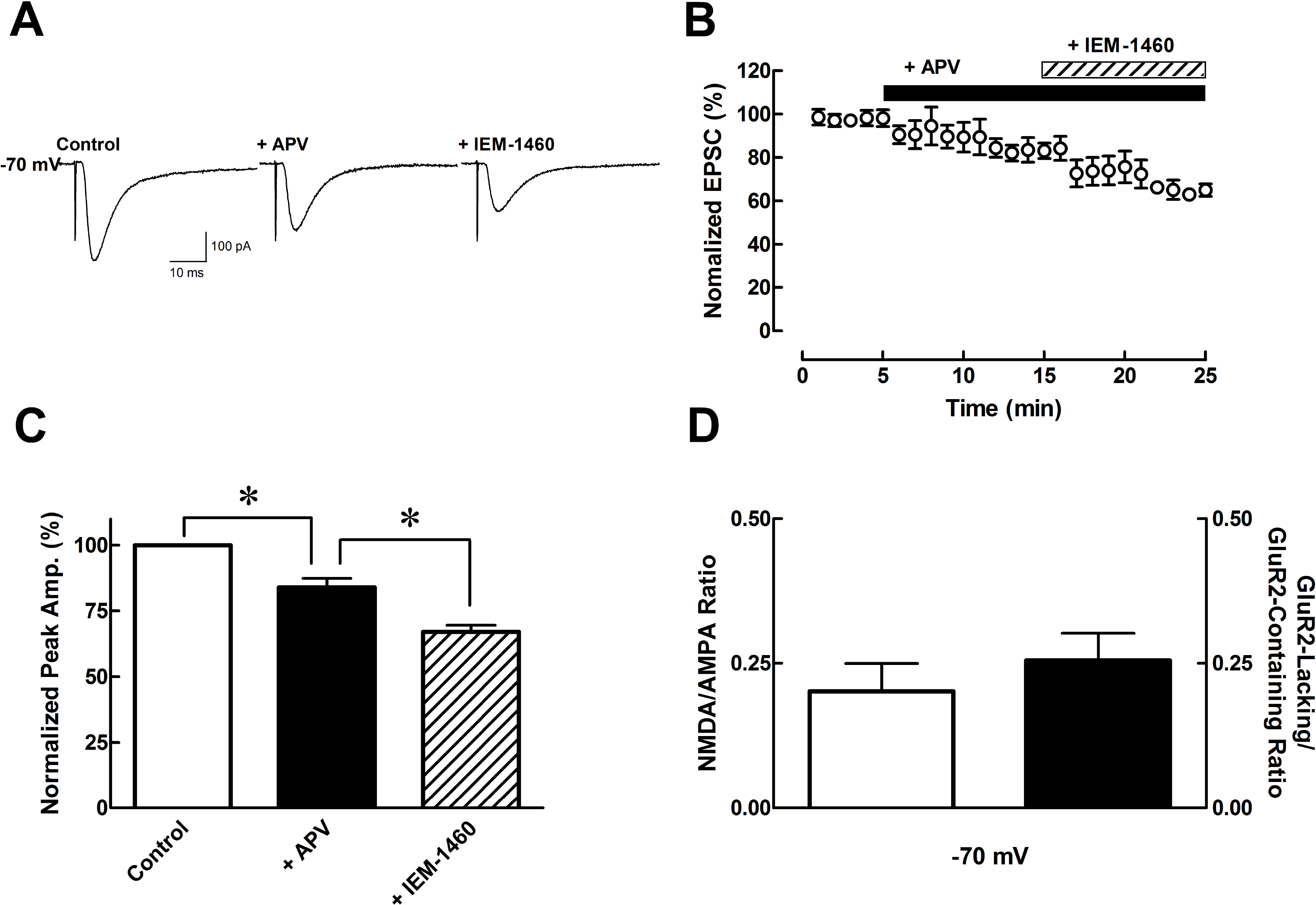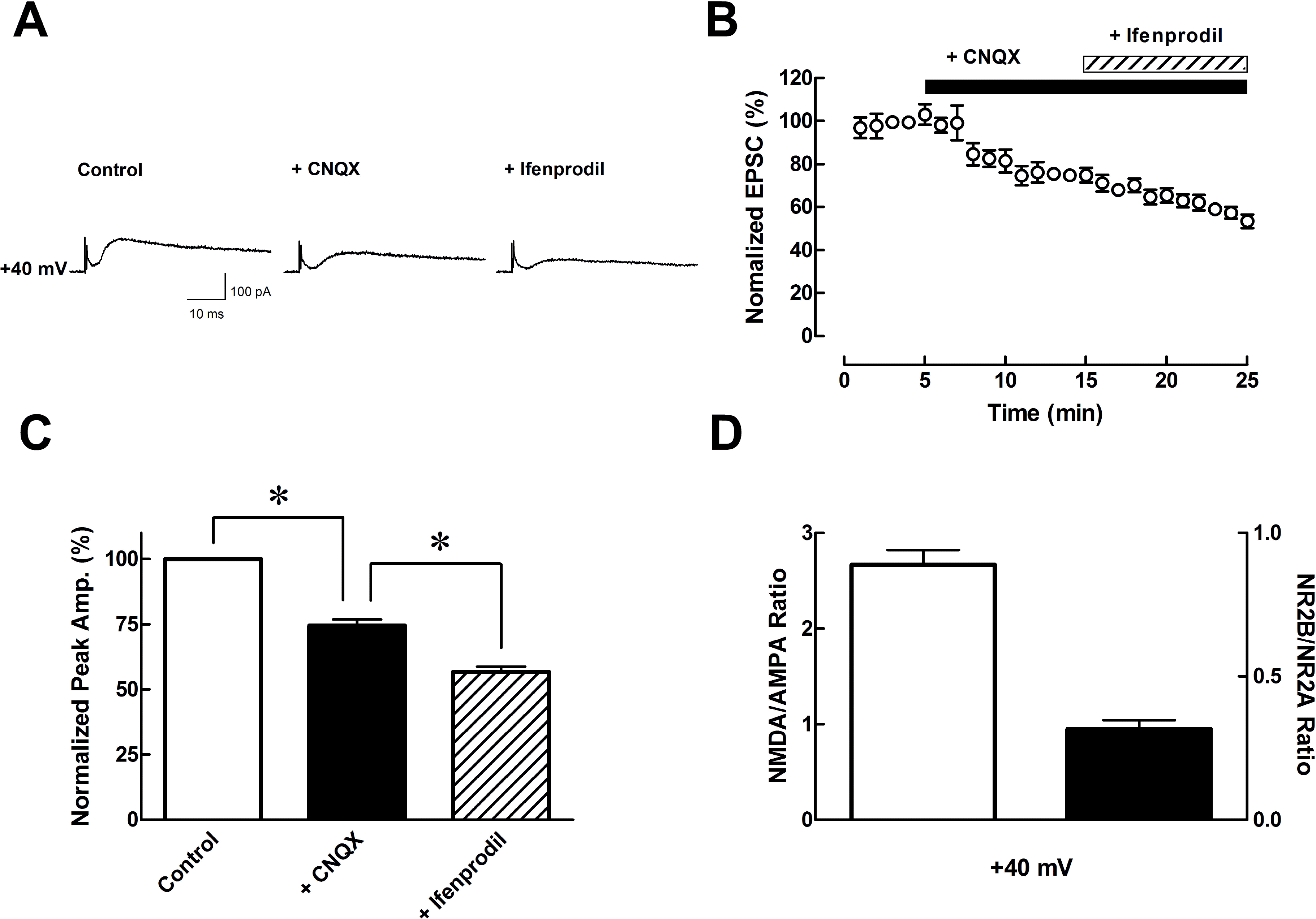Abstract
The striatum receives glutamatergic afferents from the cortex and thalamus, and these synaptic transmissions are mediated by α-amino-3-hydroxy-5-methyl-4-isoxazolepropionate (AMPA) and N-methyl-D-aspartate (NMDA) receptors. The purpose of this study was to characterize glutamate receptors by analyzing NMDA/AMPA ratio and rectification of AMPA and NMDA excitatory postsynaptic currents (EPSCs) using a whole-cell voltage-clamp method in the dorsal striatum. Receptor antagonists were used to isolate receptor or subunit specific EPSC, such as (DL)-2-amino-5-phosphonovaleric acid (APV), an NMDA receptor antagonist, ifenprodil, an NR2B antagonist, CNQX, an AMPA receptor antagonist and IEM-1460, a GluR2-lacking AMPA receptor blocker. AMPA and NMDA EPSCs were recorded at −70 and +40 mV, respectively. Rectification index was calculated by current ratio of EPSCs between +50 and −50 mV. NMDA/AMPA ratio was 0.20±0.05, AMPA receptor ratio of GluR2-lacking/GluR2-containing subunit was 0.26±0.05 and NMDA receptor ratio of NR2B/NR2A subunit was 0.32±0.03. The rectification index (control 2.39±0.27) was decreased in the presence of both APV and combination of APV and IEM-1460 (1.02±0.11 and 0.93±0.09, respectively). These results suggest that the major components of the striatal glutamate receptors are GluR2-containing AMPA receptors and NR2A-containing NMDA receptors. Our results may provide useful information for corticostriatal synaptic transmission and plasticity studies.
Go to : 
REFERENCES
Adesnik H., Nicoll RA. Conservation of glutamate receptor 2-containing AMPA receptors during long-term potentiation. J Neurosci. 27:4598–4602. 2007.

Bliss TV., Collingridge GL. A synaptic model of memory: long-term potentiation in the hippocampus. Nature. 361:31–39. 1993.

Buldakova SL., Kim KK., Tikhonov DB., Magazanik LG. Selective blockade of Ca2+ permeable AMPA receptors in CA1 area of rat hippocampus. Neuroscience. 144:88–99. 2007.
Cho HS., Lee HH., Choi SJ., Kim KJ., Jeun SH., Li QZ., Sung KW. Forskolin enhances synaptic transmission in rat dorsal striatum though NMDA receptors and PKA in different phases. Korean J Physiol Pharmacol. 12:293–297. 2008.
Choi SJ., Kim KJ., Cho HS., Kim SY., Cho YJ., Hahn SJ., Sung KW. Acute inhibition of corticostriatal synaptic transmission in the rat dorsal striatum by ethanol. Alcohol. 40:95–101. 2006.

Derkach VA., Oh MC., Guire ES., Soderling TR. Regulatory mechanisms of AMPA receptors in synaptic plasticity. Nat Rev Neurosci. 8:101–113. 2007.

Ding J., Peterson JD., Surmeier DJ. Corticostriatal and thalamostriatal synapses have distinctive properties. J Neurosci. 28:6483–6492. 2008.

Du J., Creson TK., Wu LJ., Ren M., Gray NA., Falke C., Wei Y., Wang Y., Blumenthal R., Machado-Vieira R., Yuan P., Chen G., Zhuo M., Manji HK. The role of hippocampal GluR1 and GluR2 receptors in manic-like behavior. J Neurosci. 28:68–79. 2008.

Greger IH., Khatri L., Ziff EB. RNA editing at arg607 controls AMPA receptor exit from the endoplasmic reticulum. Neuron. 34:759–772. 2002.

Jonas P., Burnashev N. Molecular mechanisms controlling calcium entry through AMPA-type glutamate receptor channels. Neuron. 15:987–990. 1995.

Kreitzer AC., Malenka RC. Endocannabinoid-mediated rescue of striatal LTD and motor deficits in Parkinson's disease models. Nature. 445:643–647. 2007.

Lau CG., Zukin RS. NMDA receptor trafficking in synaptic plasticity and neuropsychiatric disorders. Nat Rev Neurosci. 8:413–426. 2007.

Liu L., Wong TP., Pozza MF., Lingenhoehl K., Wang Y., Sheng M., Auberson YP., Wang YT. Role of NMDA receptor subtypes in governing the direction of hippocampal synaptic plasticity. Science. 304:1021–1024. 2004.

Massey PV., Johnson BE., Moult PR., Auberson YP., Brown MW., Molnar E., Collingridge GL., Bashir ZI. Differential roles of NR2A and NR2B-containing NMDA receptors in cortical long-term potentiation and long-term depression. J Neurosci. 24:7821–7828. 2004.

McDermott CM., Hardy MN., Bazan NG., Magee JC. Sleep deprivation-induced alterations in excitatory synaptic transmission in the CA1 region of the rat hippocampus. J Physiol. 570:553–565. 2006.

Nansen EA., Jokel ES., Lobo MK., Micevych PE., Ariano MA., Levine MS. Striatal ionotropic glutamate receptor ontogeny in the rat. Dev Neurosci. 22:329–340. 2000.

Panicker S., Brown K., Nicoll RA. Synaptic AMPA receptor subunit trafficking is independent of the C terminus in the GluR2-lacking mouse. Proc Natl Acad Sci U S A. 105:1032–1037. 2008.

Parsons CG., Danysz W., Quack G. Glutamate in CNS disorders as a target for drug development: an update. Drug News Perspect. 11:523–569. 1998.

Schotanus SM., Chergui K. Long-term potentiation in the nucleus accumbens requires both NR2A- and NR2B-containing N-methyl-D-aspartate receptors. Eur J Neurosci. 27:1957–1964. 2008.

Standaert DG., Testa CM., Young AB., Penney JB Jr. Organization of N-methyl-D-aspartate glutamate receptor gene expression in the basal ganglia of the rat. J Comp Neurol. 343:1–16. 1994.

Sung KW., Choi S., Lovinger DM. Activation of group I mGluRs is necessary for induction of long-term depression at striatal synapses. J Neurophysiol. 86:2405–2412. 2001.
Tardin C., Cognet L., Bats C., Lounis B., Choquet D. Direct imaging of lateral movements of AMPA receptors inside synapses. EMBO J. 22:4656–4665. 2003.

Go to : 
 | Fig. 1.Pharmacological isolation of AMPA receptors. (A) Sample traces of EPSCs with continuously added specific antagonist such as APV (NMDA receptor antagonist, 50 μM), and IEM-1460 (GluR2-lacking AMPA receptor blocker, 100 μM), respectively. (B) Plot graph shows baseline, addition of APV, and IEM-1460 by 10 min interval, tendency decreased EPSCs by APV and IEM-1460 (n=6). (C) Bar graph shows average peak data normalized to control (open bar) currents. ∗p<0.05, when compared to control versus APV and APV versus IEM-1460. (D) Bar graph shows NMDA/AMPA ratio and GluR2-lacking AMPA receptor/GluR2-containing AMPA receptor ratio calculated by data from Fig. 1C. Data are expressed as mean±S.E.M. |
 | Fig. 2.Pharmacological isolation of NMDA receptors. (A) Sample traces of EPSCs with continuously added specific antagonist such as CNQX (AMPA receptor antagonist, 10 μM), and ifenprodil (NMDA receptor subunit NR2B blocker, 3 μM), respectively. (B) Plot graph shows baseline, addition of CNQX, and ifenprodil by 10 min interval, tendency decreased EPSCs by CNQX, and ifenprodil (n=6). (C) Bar graph shows average peak data normalized to control (open bar) currents. ∗p<0.05, when compared to control versus CNQX and CNQX versus ifenprodil. (D) Bar graph shows NMDA/AMPA ratio and NR2B NMDA receptor subunit/NR2A NMDA receptor subunit ratio calculated by data from Fig. 2C. Data are expressed as mean±S.E.M. |
 | Fig. 3.Rectification pattern of synaptic responses in rat striatum. Current/voltage curve and bar graph shows the rectification pattern and the rectification index. (A) Current/voltage curve showing the rectification pattern of control, APV, combination of IEM-1460 and APV, CNQX and combination of ifenprodil and CNQX. (B) Bar graph showing the rectification index (current ratio between +50 mV and −50 mV) of control, APV and combination of APV and IEM-1460 (n=7). Data are expressed as mean±S.E.M. |




 PDF
PDF ePub
ePub Citation
Citation Print
Print


 XML Download
XML Download